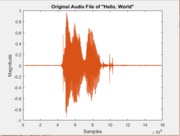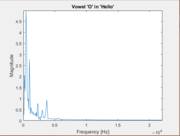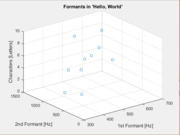| Line 7: | Line 7: | ||
== Challenges == | == Challenges == | ||
| − | The toughest part of the original plan was in finding a table that mapped out the formants of the 42 phonemes [1] in the English language. This left me with nothing to compare my results to so the computer had no viable data to use. For this reason, I changed the direction of the project to the current goal. | + | The toughest part of the original plan was in finding a table that mapped out the formants of the 42 phonemes [1] in the English language. This left me with nothing to compare my results to so the computer had no viable data to use. For this reason, I changed the direction of the project to the current goal. Additionally, it was hard, even as a native English speaker, to understand how the IPA is set up [3]. In essence, it was difficult to get through the literature and understand how to accurately map a word, preserving each sound. Charts were found for vowels, however. The phonemes were found for each word [4], but there were no data about their corresponding formants. |
== Approach == | == Approach == | ||
| Line 13: | Line 13: | ||
Once I had the audio file, I manually trimmed the data to, basically, get rid of any dead time. One assumption I made was that each of the 10 letters lasted the same amount of time. For this reason, I took 10 DFTs using the 'DFTwin' function we created in lab 9a [1]. From there, I extracted the first 2 largest peaks (the formants). Once I had these, I was able to plot them in 3-space with respect to the letters. | Once I had the audio file, I manually trimmed the data to, basically, get rid of any dead time. One assumption I made was that each of the 10 letters lasted the same amount of time. For this reason, I took 10 DFTs using the 'DFTwin' function we created in lab 9a [1]. From there, I extracted the first 2 largest peaks (the formants). Once I had these, I was able to plot them in 3-space with respect to the letters. | ||
| − | |||
| − | |||
| − | |||
| − | |||
| − | |||
[[File:Audio.PNG|thumbnail]] | [[File:Audio.PNG|thumbnail]] | ||
[[File:Code.PNG|thumbnail|Matlab Code]] | [[File:Code.PNG|thumbnail|Matlab Code]] | ||
[[File:O Hello.PNG|thumbnail]] | [[File:O Hello.PNG|thumbnail]] | ||
| − | https://en.wikipedia.org/wiki/International_Phonetic_Alphabet | + | |
| − | http://phonemicchart.com/transcribe/1000_basic_words.html | + | == Conclusion == |
| + | |||
| + | In a strange (and error-prone way), I was able to collect some data about my speech and where exactly my formants lie. | ||
| + | [[File:3D plot.PNG|thumbnail]] | ||
| + | |||
| + | |||
| + | |||
| + | [1] Purdue ECE 438, "ECE438 - Laboratory 9: Speech Processing (Week 1)", October 6, 2010, | ||
| + | https://engineering.purdue.edu/VISE/ee438L/lab9/pdf/lab9a.pdf. | ||
| + | |||
| + | Lab used for general direction and background information, including the formant chart for vowels | ||
| + | |||
| + | [2] http://www.zamzar.com/ | ||
| + | |||
| + | Free online software used to convert the audio file | ||
| + | |||
| + | [3] https://en.wikipedia.org/wiki/International_Phonetic_Alphabet | ||
| + | |||
| + | Background information on how the words are structured and understood | ||
| + | |||
| + | [4] http://phonemicchart.com/transcribe/1000_basic_words.html | ||
| + | |||
| + | Used to get the official phonetic spelling for both words | ||
Revision as of 22:43, 23 April 2017
Hello, World!
by Alden Fisher
Introduction
My original intent was to insert an audio file into Matlab and have it print out what I was saying in plain text. This proved to be a challenge for several reasons which I will get to later. What I ended up doing instead was finding the 1st and 2nd formants in the famous sentence "Hello, world."
Challenges
The toughest part of the original plan was in finding a table that mapped out the formants of the 42 phonemes [1] in the English language. This left me with nothing to compare my results to so the computer had no viable data to use. For this reason, I changed the direction of the project to the current goal. Additionally, it was hard, even as a native English speaker, to understand how the IPA is set up [3]. In essence, it was difficult to get through the literature and understand how to accurately map a word, preserving each sound. Charts were found for vowels, however. The phonemes were found for each word [4], but there were no data about their corresponding formants.
Approach
I audio recorded me in a quiet room saying the phrase "Hello, World." This was recorded on my iPhone which has a sampling rate of 44.1kHz. From there, I converted the file [2] to a '.wav' so that it would be compatible on all computing platforms. Once I had the audio file, I manually trimmed the data to, basically, get rid of any dead time. One assumption I made was that each of the 10 letters lasted the same amount of time. For this reason, I took 10 DFTs using the 'DFTwin' function we created in lab 9a [1]. From there, I extracted the first 2 largest peaks (the formants). Once I had these, I was able to plot them in 3-space with respect to the letters.
Conclusion
In a strange (and error-prone way), I was able to collect some data about my speech and where exactly my formants lie.
[1] Purdue ECE 438, "ECE438 - Laboratory 9: Speech Processing (Week 1)", October 6, 2010, https://engineering.purdue.edu/VISE/ee438L/lab9/pdf/lab9a.pdf.
Lab used for general direction and background information, including the formant chart for vowels
Free online software used to convert the audio file
[3] https://en.wikipedia.org/wiki/International_Phonetic_Alphabet
Background information on how the words are structured and understood
[4] http://phonemicchart.com/transcribe/1000_basic_words.html
Used to get the official phonetic spelling for both words





